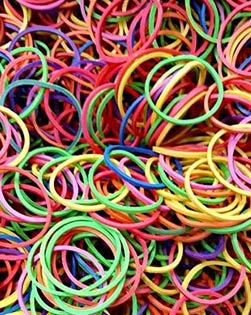Rubber bands are a stretch of rubber and latex in the shape of a loop and are widely used to hold objects together. Rubber bands are known by various names like binder, elastic, elastic bands, lacker band or gumband. These bands are frequently used in many businesses, industries as well as at home. They are well suited for holding multiple objects together and are reusable and economical. Rubber band sizes vary according to their intended use. These elastic rubber band colors too differ. Today, in the 21st century, rubber bands are considered one of the most convenient rubber products, used by many individuals and industries for a wide variety of purposes. Industrial rubber bands are made to perform heavy duty. These industrial rubber bands have specific sizes and are very strong rubber bands , designed to stabilize almost any size load.
Manufacturing Process of Rubber Band
Rubber bands manufacturers make them by extruding rubber into a long tube to give its general shape, placing these tubes on mandrels and curing the rubber with heat, slicing it across the width of the tube into small rubber bands. For making the long rubber tube, the rubber band manufacturers use high grade synthetic rubber, which is then sliced into little bands. Rubber bands are also manufactured using natural rubber because of its superior elasticity. With the vulcanization process and emergence of synthetic rubber, these bands have become more durable and elastic. The size of a small rubber band can be less than an inch in diameter, while large rubber bands can be several feet across. For detailed manufacturing process of rubber band, read our article Rubber Bands: The Making

Rubber Bands Sizes and Measuring
Standard rubber bands are assigned a "size number" that corresponds to the dimensions of the elastic rubber band - its length, width and thickness dimensions. Following are the details of the measuring of rubber band sizes-
- Length: The length of a band is half its circumference.
- Thickness: The thickness of rubber band is the distance from its inner circle to the outer circle.
- Width: The height of that band or cylinder is its width.
There are various number of standard rubber band sizes available in the market. If the appropriate size is not available with the rubber bands wholesale suppliers, they can get custom rubber bands made through the rubber band manufacturers according to customers' exact specifications. Customers can specify the diameter, width, and wall thickness of the rubber band size that they require. They can also get printed custom rubber bands.
Rubber Bands Size Numbers
Rubber Bands Size NumbersRubber bands are given a standard number based on dimensions. Usually the are numbered starting from smallest to largest, width first. Therefore, rubber bands numbered 8-19 are 1/16 inch wide, with length ranging from 7/8 inch to 3 1/2 inches. The numbers 30-34 are 1/8 inch wide, going again from shorter to longer. Even for long rubber bands, the numbering starts over for numbers above 100, again starting at width 1/16 inch.
Types of Rubber Used in Rubber Bands
All rubber bands are not made of the same material. There are four primary materials used to make them. They are Natural Rubber, Ethylene Propylene Diene Monomer (EPM, EPDM), Synthetic polyisoprene, and Silicone compounds. These materials have special properties that make them best for certain jobs.
Rubber Bands Uses
The rubber bands are used to hold a large number of things such as follows:
- They are used to suspend hard drives in a computer case. Suspending hard drives help in avoiding contact between the hard drives and the computer case. This in turn results in reducing vibrations to the case, thereby reducing noise in the computer case.
- They are often used in orthodontics. This helps to realign teeth over a period of time.
- They can also serve the purpose of an eraser by simply wrapping a rubber band tightly around the end of a pencil.
- They are used during aerobic exercising as fitness tools. In fact, the wrist rubber bands are an important sports accessories too.
- They are sometimes used to power model aircraft or other mechanical toys because of its property of stretchable. When the rubber band untwists itself, it will help to rotate the wings affixed to it.
- They are used as projectiles.
- They are used to hold small objects or file papers or in many official uses etc.
Applications of Rubber Bands
Rubber Bands have an extensive range of applications in both heavy and small industries like agriculture,packaging, stationery, fishery, transportation, leisure trades etc. the heavy duty industrial rubber bands are used for more demanding jobs.
Rubber Bands Consumption in US
Rubber bands have a large variety of uses and have become one of the United States business staple over the years. The largest consumer of rubber bands in the world is the U.S. Post Office. There is annual order of millions of pounds of bands which are used in sorting and delivering piles of mail. The newspaper industry also uses their large quantities to keep individual newspapers rolled or folded before they are delivered from home to home. Another large consumer of rubber band is the agricultural products industry. The flower industry uses them to hold together bouquets. They are also tied around the petals of flowers (especially tulips) to keep them from opening in transit. Vegetables such as celery are bunched together with the help of these bands. The plastic coverings over broccoli, cauliflower, other vegetables and fruits are often tied with them. All in all, more than 30 million pounds of rubber bands are sold in the United States alone each year.
Buying Tips for Wholesale Rubber Bands
For wholesale rubber bands purchase, the basic factors that must be taken into consideration are as follows:
- Highest count per pound
- Highest tensile strength
- Soft stretch
- Highest rubber content
RELATED ARTICLES
- Anti Vibration Mountings
- Automobile Rubber Products
- Calendered Rubber Products
- Extruded Rubber Products
- Medical Rubber Products
- Metal Bonded Components
- Rubber Adhesives & Sealants
- Rubber Ball
- Rubber Bands
- Rubber Beading
- Rubber Bearing
- Rubber Belt
- Rubber Buckets
- Rubber Bullets
- Rubber Cable
- Rubber Coating
- Rubber Duct
- Rubber Expansion Joints
- Rubber Flooring/Matting
- Rubber Footwear
- Rubber Gloves
- Rubber Injection Parts
- Rubber Lining
- Rubber Magnets
- Rubber Molded Products
- Rubber Pads
- Rubber Rollers
- Rubber Stopper
- Rubber Suit
- Rubber Track
- Rubber Valve
- Rubber Balloon
- Rubber Stamps
- Rubber Fenders
- Acrylic Rubber (ACM)
- Butadiene Rubber (BR)
- Butyl Rubber (IIR)
- Chlorosulfonated Polyethylene(CSM)/ Hypalon
- Ethylene Propylene Diene Monomer
- Fluoroelastomers (FKM)/Viton
- Isoprene Rubber (IR)
- Nitrile Rubber (NBR)
- Perfluoroelastomer (FFKM)
- Polychloroprene (CR)/Neoprene
- Polysulfide Rubber (PSR)
- Silicone Rubber (SiR)
- Styrene Butadiene Rubber
How to Make a Custom Rubber Stamp?
Whenever designing a custom stamp for your company, never compromise on its quality because in the end it is the most...
Read MoreLatex and Silicone Rubber Tubing - A Comparison!
Many industries use rubber tubing for various purposes. In fact, various types of rubber tubing are used for different applications...
Read MoreSilicone vs Acrylic Adhesive- A Comparison
Silicon and acrylic adhesives are those rubber adhesives that are widely used in Polyimide tapes. In fact, the polyimide...
Read More

